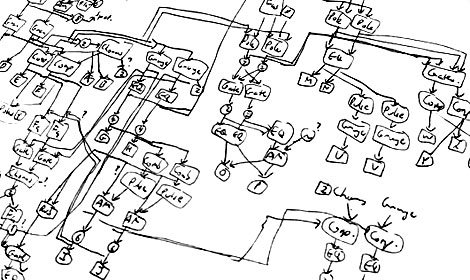The original premise behind this piece was quite simple.

After some trial and error, a working model was hammered into shape.

A further year of development and the piece is now perfected.

The patch was constructed in AudioMulch, using only the components that come as standard with the software except for one freeware signal modeller at the very last stage.
In the above diagram it should be clear that there are no inputs to the system. None of the components play samples or generate signals. The patch is a network of interacting feedback circuits.
The network is played by sending MIDI instructions to the various controls on each component. During a performance, the system typically receives about 1000 MIDI commands per minute. To do this, I had to write a script that would generate a MIDI file containing all the instructions.

The script inserts commands and controller values according to (pseudo)random numbers. Randomness has to be used thoughtfully to get interesting, distinctive results, so a lot of revising, tweaking and polishing went into writing the script. The user can define basic parameters and bias weightings (duration, amount of activity) when the script is run.
The result?
Just now I’ve added another element: human intervention. For my upcoming live shows I will be playing these pieces directly from the patch and the script. Even when playing from the same score, the system will produce different sounds each time it is run: the score determines its behaviour, not its output. In the live shows I will be playing a MIDI controller to insert additional commands, which may have an immediate or delayed effect on the system.
